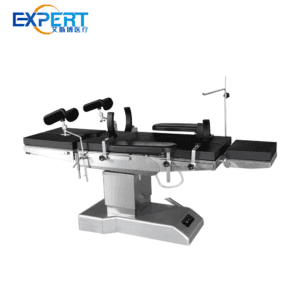عنوان
304 شارع الكاردينال الشمالي
مركز دورتشستر ، ماساتشوستس 02124
ساعات العمل
من الاثنين إلى الجمعة: 7 صباحًا - 7 مساءً
عطلة نهاية الأسبوع: 10 صباحًا - 5 مساءً
عنوان
304 شارع الكاردينال الشمالي
مركز دورتشستر ، ماساتشوستس 02124
ساعات العمل
من الاثنين إلى الجمعة: 7 صباحًا - 7 مساءً
عطلة نهاية الأسبوع: 10 صباحًا - 5 مساءً
In the realm of modern surgery, success hinges on a delicate balance between surgical skill, advanced technology, and the supporting cast that often goes unnoticed – the operating table. Beyond being a mere platform, the operating table is a pivotal component that can profoundly influence patient outcomes. This article delves into the intricate relationship between operating tables and surgical success, exploring how these essential tools contribute to improved patient outcomes and the advancement of medical excellence.

The operating table serves as a canvas upon which surgical mastery is painted. Its positioning, stability, and adjustability play a crucial role in enabling surgeons to execute procedures with precision. Surgeons rely on operating tables to provide optimal patient positioning, ergonomic support, and stability, all of which directly impact their ability to navigate complexities and achieve successful outcomes.
In the realm of minimally invasive surgery, the operating table’s significance becomes even more pronounced. Surgeons must navigate intricate pathways through small incisions, relying on the table to facilitate optimal patient positioning for accurate instrument placement. The integration of advanced imaging technologies and the compatibility of the table with these systems enhance visualization and procedural precision.
Operating tables contribute to patient safety by providing stability and comfort during procedures. Proper positioning ensures that patients remain secure throughout surgery, minimizing the risk of inadvertent movement that could compromise surgical accuracy. Patient comfort also reduces the likelihood of complications, enhancing the overall safety of the procedure.
Advanced operating tables incorporate pressure distribution technology that minimizes the risk of pressure ulcers, particularly during lengthy surgeries. By evenly distributing pressure across the patient’s body, these tables mitigate the potential for skin breakdown and associated complications, aligning with the broader goal of patient well-being.
The ergonomic design of operating tables is essential in supporting surgeon performance. Surgeons often spend hours in the operating room, performing intricate procedures that demand sustained focus. Ergonomically designed tables allow surgeons to maintain comfortable positions, reducing fatigue and enhancing concentration, which are critical factors in achieving optimal surgical outcomes.
Ergonomic operating tables play a vital role in enhancing surgeon concentration and procedural precision. Surgeons can adjust the table to their preferred working height and angles, enabling them to work in a position that minimizes strain and maximizes control over instruments. This level of customization translates into fine-tuned movements and improved procedural accuracy.
Modern operating tables seamlessly integrate with imaging technologies such as fluoroscopy and C-arms. This integration ensures that surgeons can visualize anatomical structures in real time, allowing for adjustments and modifications during surgery. The synergy between the table and imaging systems enhances decision-making and procedural accuracy.
The future of operating tables includes the integration of robotic assistance, enhancing procedural precision. Robotic components can collaborate with surgeons, amplifying dexterity and enabling finer movements. This partnership between humans and machines redefines the boundaries of surgical excellence.

Operating tables are more than inanimate objects; they are dynamic instruments that shape surgical success. By providing stability, ergonomic support, and compatibility with advanced technologies, these tables empower surgeons to perform with unparalleled precision. As surgical techniques advance and patient expectations rise, the role of operating tables in achieving successful outcomes becomes even more critical.
س 1: How do operating tables contribute to patient safety during surgery?
أ1: Operating tables provide stability and proper positioning for patients, reducing the risk of movement-related complications during surgery.
س 2: Can operating tables accommodate different surgical specialties?
أ2: Yes, modern operating tables are designed to be versatile and can accommodate a wide range of surgical specialties and procedures.
س 3: How do ergonomic operating tables enhance surgeon performance?
أ3: Ergonomic tables enable surgeons to maintain comfortable positions during procedures, reducing fatigue and enhancing concentration and precision.
س 4: How does the integration of imaging technologies enhance surgical outcomes?
أ4: Operating tables that integrate imaging technologies allow surgeons to visualize real-time images of anatomical structures, enhancing decision-making and procedural accuracy.
س 5: What is the role of robotic assistance in the future of operating tables?
أ5: Robotic assistance integrated into operating tables can enhance procedural precision by providing finer movements and amplifying the surgeon’s capabilities.
The symbiotic relationship between surgeons and operating tables underscores the pursuit of surgical excellence. Operating tables are not mere platforms; they are partners in the quest for successful outcomes. By providing stability, supporting ergonomic needs, and seamlessly integrating with advanced technologies, operating tables elevate the art of surgery to new heights. As medical advancements continue to shape the landscape of healthcare, the operating table remains a cornerstone of success, a conduit through which surgical mastery is channeled to benefit patient well-being and redefine the boundaries of medical achievement.